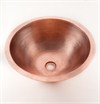Antimicrobial Copper Sinks
|
|
Elkay - Elkay is a household name when it comes to quality sinks for healthcare, corporate, and residential environments. As an industry leader, Elkay has exceeded expectations yet again with their new line of antimicrobial sinks. Products: Sinks. Contact - Aaron Rosso 800-223-5529 |
|
|
|
Hussey Copper - Today you can rely on us for a new generation of stylish MD-Cu29 antimicrobial copper products for all of your commercial and residential touch surfaces needs. And as an integrated manufacturer, Hussey Copper manages the entire supply chain and fabrication process. These handcrafted, one-of-a-kind MD-Cu29 antimicrobial copper sinks come in 4 different styles to match any type of bath decor project. Products: Sinks and Tile. Contact - Hussey Copper Customer Care Team 844-894-5501
|
|
|
|
Just Manufacturing - As a leading manufacturer of hospital fixtures for years, Just Manufacturing provides the utmost quality, while ensuring flexibility for creative design and optimal aesthetics. New healthcare fixtures, scrub sinks, and handwash stations made with CuVerro antimicrobial copper are a needed component for infection control environments. Products: Sinks. Contact - Brian Smith 847-678-5151 |
|

Categories of Antimicrobial Copper Products
If you wish to download a PDF version of the product catalog, click here.
*Laboratory testing shows that, when cleaned regularly, antimicrobial copper surfaces kill greater than 99.9% of the following bacteria within 2 hours of exposure: MRSA, VRE, Staphylococcus aureus, Enterobacter aerogenes, Pseudomonas aeruginosa, and E. coli O157:H7. Antimicrobial copper surfaces are a supplement to and not a substitute for standard infection control practices and have been shown to reduce microbial contamination, but do not necessarily prevent cross contamination or infections; users must continue to follow all current infection control practices.






